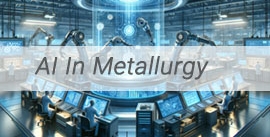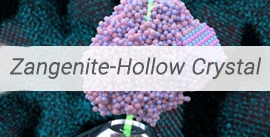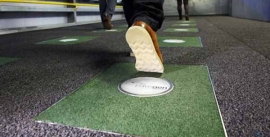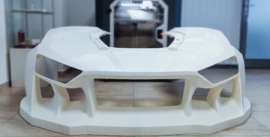 جدید
جدیدسیستم برق سرخود، شیشه های هوشمند را هوشمندتر میسازد !!! Self-powered system makes smart windows smarter
شیشه های هوشمند
سیستم برق سرخود، شیشه های هوشمند را هوشمندتر میسازد !!!
Self-powered system makes smart windows smarter
محققین گونهی جدیدی از شیشه های هوشمند را ابداع کردند: پنجرهای با توانایی تولید و تامین برق مورد نیاز خود که ارزان بوده و به سادگی روی پنجرههای موجود قابل نصب میباشد، با پتانسیل حفظ گرمای داخل و کاهش هزینههای سرمایش ابداع شده است. این پنجره با استفاده از یک سلول خورشیدی که از محدودهی ماورابنفش نور خورشید استفاده میکند، برق مورد نیاز خود را تامین میکند.
——————————————————–
ترجمه از گروه ترجمه ایران مواد
حرفه ای ترین تیم ترجمه مهندسی مواد کشور
———————————————————
شیشه های هوشمند مجهز به پوششی قابل کنترل و سیستمهای افزایش نور، سرمایش و گرمایش با تغییر رنگ، به طور میانگین میتوانند ۴۰ درصد در مصرف انرژی ساختمان کاهش یابند.
این پنجرهها برای عمل کردن، نیاز به برق دارند و بنابراین نصب آنها در ساختمانهای موجود کمی پیچیده و دشوار میباشد. اما با به کارگیری تکنولوژی جدید سلول خورشیدی توسط محققین دانشگاه Princeton نوع متفاوت و جدیدی از شیشههای هوشمند ارائه شده است. پنجرهای با توانایی تولید و تامین برق مورد نیاز خود که ارزان بوده و به سادگی روی پنجرههای موجود، قابل نصب میباشد، با پتانسیل حفظ گرمای داخل و کاهش هزینههای سرمایش ابداع شده است. این سیستم سلول خورشیدی به طور انتخابی طول موجهای UV نزدیک را جذب کرده و آز آن برق تولید میکند و در نتیجه این سیستم جدید کاملا برق سرخود میباشد.
دکترLoo Yueh Lin رئیس مرکز انرژی و محیط زیست Andlinger در این باره گفته است: “نور خورشید ترکیبی از امواج الکترومغناطیس تشکیل شده از اشعههای UV، نور مرئی و امواج مادون قرمز(حرارت) میباشد. ما به دنبال پنجرههای هوشمندی هستیم که بتوان به صورت دینامیکی میزان عبور نور و گرما از آن را کنترل کرد که منجر به ذخیرهی انرژی و بهبود راحتی محیط شود.”
پنجرهی هوشمند میزان عبور نور مرئی و حرارت مادون قرمز به درون ساختمان را کنترل میکند و این در حالی است که این سلول خورشیدی جدید از اشعهی UV نزدیک برای تولید برق مورد نیاز پنجره استفاده میکند.
به دلیل اینکه اشعهی UV نزدیک برای چشم انسان نامرئی میباشد، محققین به دنبال مهار آن برای تامین انرژی الکتریکی مورد نیاز برای تغییر رنگ شیشه های هوشمند هستند.
استفاده از اشعهی UV نزدیک برای برقدهی به این پنجرههای هوشمند، به معنی استفاده از بخشی از امواج خورشید که برای انسان ضرر داشته و به دنبال دفع آن هستیم، برای تولید انرژی الکتریکی میباشد و در عین حال این سلولهای خورشیدی میتوانند در نور مرئی شفاف باشند. سلولهای خورشیدی معمول ساخته شده از سیلیسیوم، به دلیل اینکه برای تولید برق از جذب نور مرئی و مادون قرمز استفاده میکنند، سیاه هستند و در نتیجه این سلولهای خورشیدی برای هدف مذکور مناسب نیستند.
در مقالهی چاپ شده در ژورنال Nature Energy، محققین بیان کردهاند که چگونه از نیمههادیهای آلی و به خصوص هگزابنزنوکرونن (cHBC) برای ساخت سلولهای خورشیدی استفاده شده است. محققین از این ماده استفاده کردهاند چرا که ساختار شیمیایی آن قابلیت این را دارد که طوری اصلاح شود که محدودهی باریکی از طول موج را جذب کند که در این مورد این محدوده، UV نزدیک بوده است. برای ساخت سلول خورشیدی مولکولهای نیمه هادی به صورت فیلمهای نازک روی شیشه رسوب داده میشوند. زمانی که سلول خورشیدی آمادهی کار میشود، نور خورشید نیمههادیهای cHBC را تهییج کرده و منجر به تولید انرژی الکتریکی میشود.
محققین همچنین شیشه های هوشمند که حاوی پلیمرهای الکتروکرومیک هستند را ساختهاند که رنگ آنها قابل کنترل میباشد و برای این تغییر رنگ نیاز به انرژی الکتریکی دارند که این انرژی میتواند توسط این سلولهای خورشیدی تامین شود. با تابش خورشید اشعهی UV نزدیک طیف آن، توسط سلول خورشیدی جذب شده و تبدیل به انرژی الکتریکی میشود، بارها در پنجرههای الکترومیک توسط این انرژی الکتریکی واکنشی درونی انجام داده و منجر به تغییر رنگ پنجره از شفاف به آبی تیره میشوند. زمانی که پنجره تیره میشود، توانایی دفع ۸۰ درصد از نور خورشید را دارد.
Nicholas Davy دانشجوی دکترای دپارتمان مهندسی پزشکی و شیمی و یکی از نویسندگان اصلی مقاله در این باره گفته است: “محققین دیگر نیز سلولهای خورشیدی شفاف را ساختهاند اما آنها برای تولید انرژی الکتریکی از امواج مادون قرمز استفاده میکنند. به دلیل اینکه امواج مادون قرمز وظیفهی انتقال حرارت را به عهده دارند، استفاده از این امواج برای تولید برق میتواند در عملکرد پنجرههای هوشمند که وظیفهی کنترل جریان انتقال حرارت ساختمان را به عهده دارند، خللی وارد کند. از طرف دیگر سلولهای خورشیدی شفاف UV نزدیک، به اندازهی سلولهای خورشیدی مادون قرمز انرژی تولید نمیکنند ولی به دلیل عدم جذب حرارت و در عین حال شفافیت، مکمل پنجرههای هوشمند هستند.
Davy در ادامه گفت: “هدف تیم پرینستون ایجاد یک ورژن جدید از سیستمهای پنجرههای هوشمند دارای سلول خورشیدی بوده است که دارای انعطاف بوده و قابلیت نصب لایهای روی پنجرههای ساختمانهای موجود را داشته باشد.” وی در ادامه افزود: “افراد میتوانند این ورقههای شیشه های هوشمند بدون سیم را به صورت چسبی به سطح داخلی پنجرههای خود چسبانده و مورد استفاده قرار دهند. سپس شما میتوانید میزان عبور نور خورشید به داخل خانه را با استفاده از یک نرمافزار روی گوشی خود کنترل کرده و از این طریق بازدهی انرژی، آسایش و حریم خصوصی را بهبود ببخشید.”
به کارگیری سلولهای خورشیدی در شیشه های هوشمند ، منجر به جذابیت بیشتر این پنجرهها شده و دیگر مجبور به استفاده از سیم برای این شیشه های هوشمند نخواهیم بود. ولتاژ تولیدی این سلولهای خورشیدی برای عملکرد این پنجرهها مناسب میباشد و بسیار جالب است که ولتاژ تولیدی این سلولهای خورشیدی حتی برای راهاندازی وسایل الکتریکی معمولی کافی میباشد.
Davy و Loo شرکت جدیدی به اسم Andluca را بر اساس تکنولوژی بیان شده در این مقاله تاسیس کرده و اکنون به دنبال دیگر کاربردهای این سلولهای خورشیدی شفاف هستند. بر این باورند که تکنولوژی سلول خورشیدی UV نزدیک دارای قابلیت به گارگیری در سنسورها و دیگر محصولات کممصرف هستند.
Loo در پایان گفت: “این سلولهای خورشیدی توانایی تولید برق کافی برای خودروها را ندارد اما میتواند کمکی برای فراهم کردن دستگاههای کوچکتر مانند فن خنککنندهی خودرو در زمانی که خودرو زیر نور خورشید پارک شده است، باشد.”
منبع: www.sciencedaily.com
مترجم : امیر اشجاری
Self-powered system makes smart windows smarter
Researchers developed a new type of smart window: a self-powered version that promises to be inexpensive and easy to apply to existing windows, with potential to save heating and cooling costs. The window powers itself with a transparent solar cell that harvests near-ultraviolet light.
Smart windows equipped with controllable glazing can augment lighting, cooling and heating systems by varying their tint, saving up to 40 percent in an average building’s energy costs.
These smart windows require power for operation, so they are relatively complicated to install in existing buildings. But by applying a new solar cell technology, researchers at Princeton University have developed a different type of smart window: a self-powered version that promises to be inexpensive and easy to apply to existing windows. This system features solar cells that selectively absorb near-ultraviolet (near-UV) light, so the new windows are completely self-powered.
“Sunlight is a mixture of electromagnetic radiation made up of near-UV rays, visible light, and infrared energy, or heat,” said Yueh-Lin (Lynn) Loo, director of the Andlinger Center for Energy and the Environment, and the Theodora D. ’78 and William H. Walton III ’74 Professor in Engineering. “We wanted the smart window to dynamically control the amount of natural light and heat that can come inside, saving on energy cost and making the space more comfortable.”
The smart window controls the transmission of visible light and infrared heat into the building, while the new type of solar cell uses near-UV light to power the system.
“This new technology is actually smart management of the entire spectrum of sunlight,” said Loo, who is a professor of chemical and biological engineering. Loo is one of the authors of a paper, published June 30, that describes this technology, which was developed in her lab.
Because near-UV light is invisible to the human eye, the researchers set out to harness it for the electrical energy needed to activate the tinting technology.
“Using near-UV light to power these windows means that the solar cells can be transparent and occupy the same footprint of the window without competing for the same spectral range or imposing aesthetic and design constraints,” Loo added. “Typical solar cells made of silicon are black because they absorb all visible light and some infrared heat — so those would be unsuitable for this application.”
In the paper published in Nature Energy, the researchers described how they used organic semiconductors — contorted hexabenzocoronene (cHBC) derivatives — for constructing the solar cells. The researchers chose the material because its chemical structure could be modified to absorb a narrow range of wavelengths — in this case, near-UV light. To construct the solar cell, the semiconductor molecules are deposited as thin films on glass with the same production methods used by organic light-emitting diode manufacturers. When the solar cell is operational, sunlight excites the cHBC semiconductors to produce electricity.
At the same time, the researchers constructed a smart window consisting of electrochromic polymers, which control the tint, and can be operated solely using power produced by the solar cell. When near-UV light from the sun generates an electrical charge in the solar cell, the charge triggers a reaction in the electrochromic window, causing it to change from clear to dark blue. When darkened, the window can block more than 80 percent of light.
Nicholas Davy, a doctoral student in the chemical and biological engineering department and the paper’s lead author, said other researchers have already developed transparent solar cells, but those target infrared energy. However, infrared energy carries heat, so using it to generate electricity can conflict with a smart window’s function of controlling the flow of heat in or out of a building. Transparent near-UV solar cells, on the other hand, don’t generate as much power as the infrared version, but don’t impede the transmission of infrared radiation, so they complement the smart window’s task.
Davy said that the Princeton team’s aim is to create a flexible version of the solar-powered smart window system that can be applied to existing windows via lamination.
“Someone in their house or apartment could take these wireless smart window laminates — which could have a sticky backing that is peeled off — and install them on the interior of their windows,” said Davy. “Then you could control the sunlight passing into your home using an app on your phone, thereby instantly improving energy efficiency, comfort, and privacy.”
Joseph Berry, senior research scientist at the National Renewable Energy Laboratory, who studies solar cells but was not involved in the research, said the research project is interesting because the device scales well and targets a specific part of the solar spectrum.
“Integrating the solar cells into the smart windows makes them more attractive for retrofits and you don’t have to deal with wiring power,” said Berry. “And the voltage performance is quite good. The voltage they have been able to produce can drive electronic devices directly, which is technologically quite interesting.”
Davy and Loo have started a new company, called Andluca Technologies, based on the technology described in the paper, and are already exploring other applications for the transparent solar cells. They explained that the near-UV solar cell technology can also power internet-of-things sensors and other low-power consumer products.
“It does not generate enough power for a car, but it can provide auxiliary power for smaller devices, for example, a fan to cool the car while it’s parked in the hot sun,” Loo said.









دیدگاه کاربران